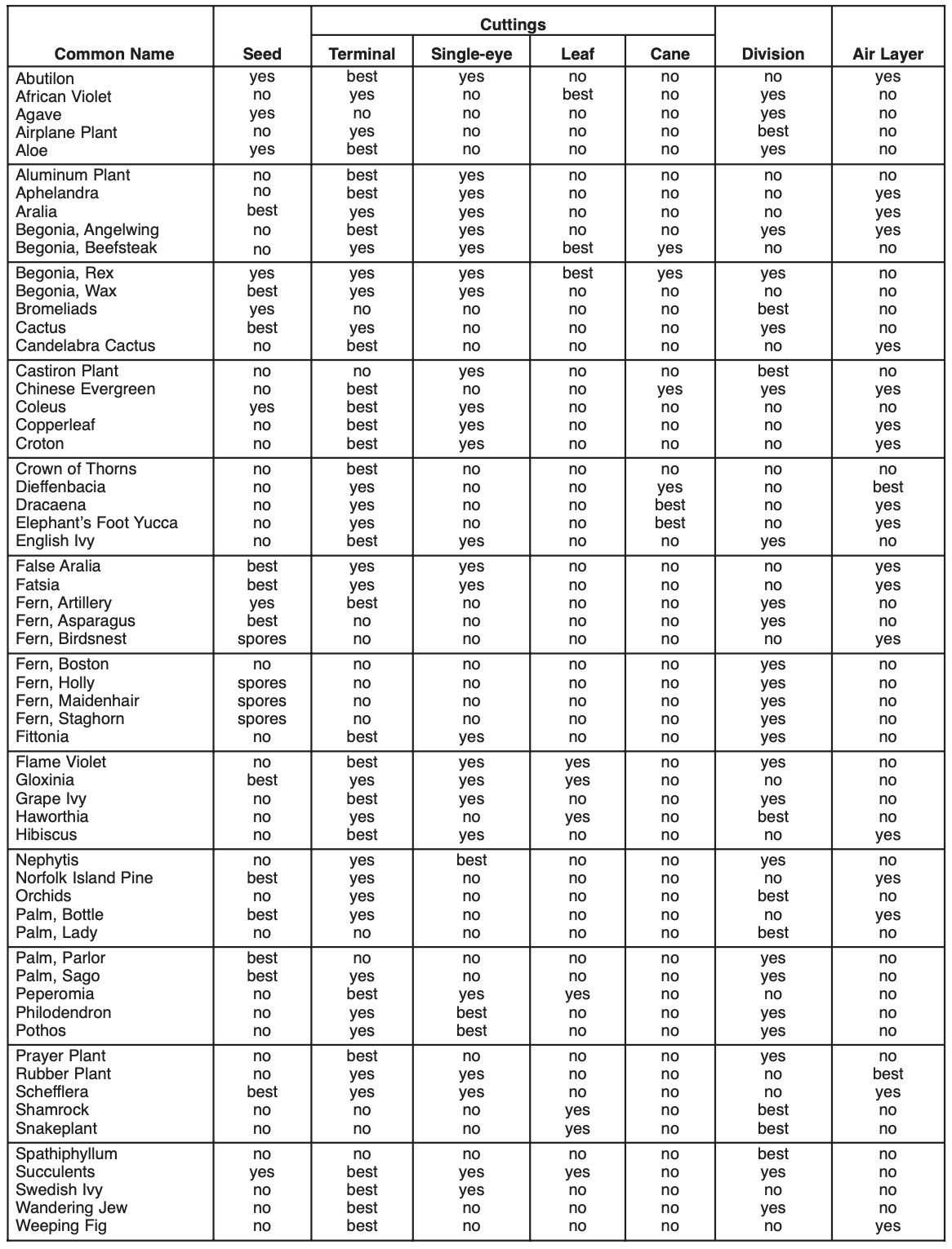How to propagate house plants
Growing new plants from an established houseplant collection is an interesting way to learn more about the habits of your plants. It is also an easy way to increase the supply of plants for personal enjoyment or to share with friends. Houseplants may be propagated in several ways. The most common methods are by:
- seeds
- terminal cuttings
- leaf cuttings
- stem cuttings
- division
- air layering
Seed Propagation
It can be more difficult to find houseplant seeds than flower seeds. Places to consider looking for seeds include online searches, mail-order companies, or advertisements in garden magazines.
House plant seeds should be fresh and planted as soon as possible as they do not tend to store very well. House plants seeds differ from seeds in temperate regions as they lack dormancy and germinate as soon as the conditions are right for them to do so. Do not chill seeds.
How do you propagate house plants using seeds?
- Seeds need to be planted three times deeper than their diameter in any organic potting soil and watered thoroughly.
- Allow excess water to drain.
- Cover with plastic bag.
- Locate seed tray where it will be warm and receive direct sunlight. The ideal soil temperature is 75 – 80 degrees.
- Seedlings should begin to appear in 2 – 4 weeks.
- Transplant seedlings to individual pots once the first true leaves develop.
Terminal Cuttings
Terminal or tip cuttings, taking a piece of the stem with one or more buds, is the most common method of propagating houseplants commercially. This technique is used on vining plants such as philodendron, ivy, pothos, and some peperomias as well as weeping figs, pileas, most cacti, wax begonias, and more.
An ideal terminal cutting is 2 – 4 inches long containing 4 – 6 leaves. Do not allow the cuttings to wilt after being removed from the joint.
How do you propagate using terminal cuttings?
-
Make a cut just below a node (the point at which leaves are attached to the stem).
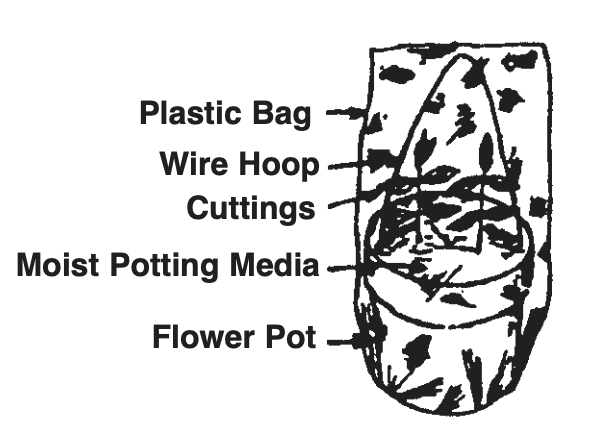 An easily constructed rooting bag to propagate different house plants
An easily constructed rooting bag to propagate different house plants - Remove the lowest pair of leaves.
- Insert the cutting into moist and sterile potting soil.
- Once cuttings are in place, make an inverted “U” shape with part of a coat hanger. Stick the inverted “U” shape into the pot in order to support a plastic bag.
- Place a clear or mostly clear plastic bag over the “U” shape. Make sure the bag is large enough to enclose the flowerpot. This creates a “rooting bag.”
- Place the rooting bag in a warm place that receives like, but not direct sunlight.
- Once the bag is sealed, do not reopen the bag until the cuttings have rooted. This takes 4 – 6 weeks.
This can also be done using the “single eye” method with plants that have an alternating leaf arrangement. These plants can be rooted by taking a piece of stem that is an inch or two in length with a leaf attached. The stem will root and the bud at the base of the leaf will form a new shoot. It is possible to make a group of six to ten single-eye cuttings in one pot to have an attractive pot in short order.
Cacti and Succulents contain a great amount of moisture and will sometimes rot in
a rooting bag. In order to avoid this, place the terminal cuttings on a windowsill
for 24 hours before placing in the rotting bag. Doing this will seal off the wounded
area which reduces the risk of decay. Water normally.
Leaf Cuttings
Leaf cuttings take two to four months to propagate due to the lack of vegetative bud. Several succulents and other thick leaved plants may be propagated by leaf cuttings.
How do you propagate using leaf cuttings?
- For plants such as African violets, peperomias and most succulents, insert the stem of the leaf up to the leaf blade. For large-leaved plants like the rex begonia, lay the leaf on the surface of the rooting medium.
- Cut the veins of the leaf in several places.
- Place small weights on the leaf to keep it in secured and in contact with the soil.
New plantlets will begin to form at the locations where the veins have been cut. The old leaf should be broken away when the new plantlets are being repotted.
Cane Cuttings
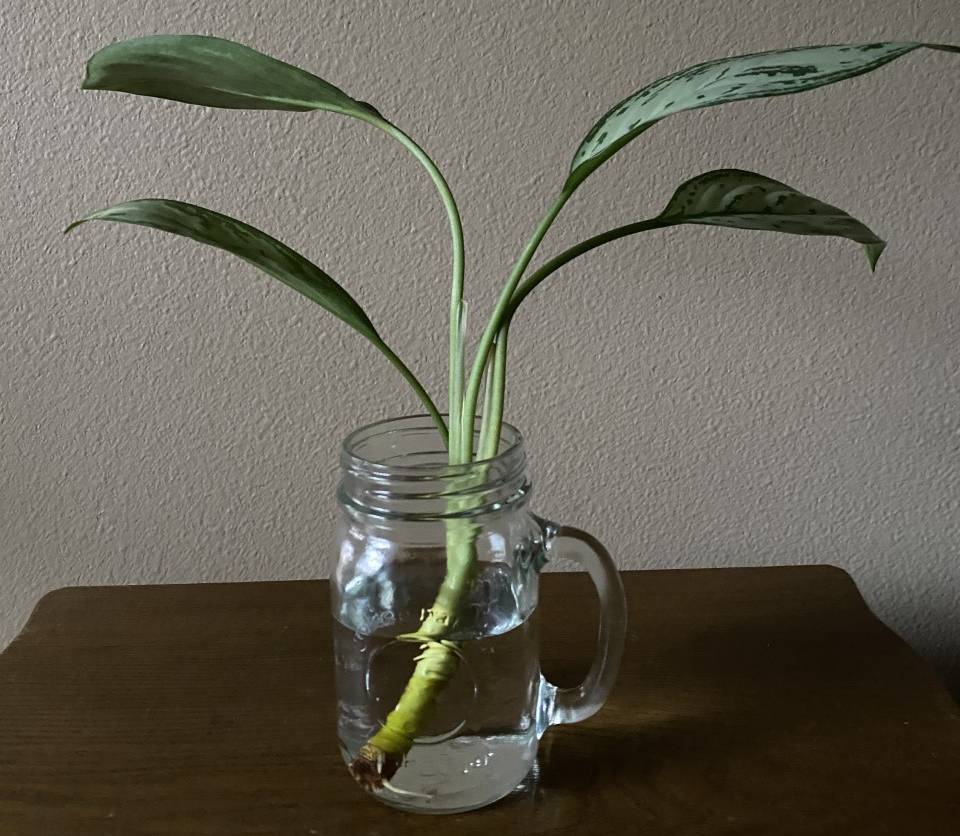
Some cane-producing plants, such as ti, dracaenas, and dumbcane can be propagated by cane cuttings. The cane can range in size from two inches to two feet long, but two-inch segments will give you the maximum number of plants per cane.
How to propagate using cane cuttings?
- Be sure there is at least one node per cane segment you cut.
- Place each segment on their side and bury them halfway in the rooting medium.
- For longer pieces of cane, insert the base of the cutting in the soil.
New roots will form from the cane and a new shoot will grow from the uppermost axillary bud.
Dividing House Plants
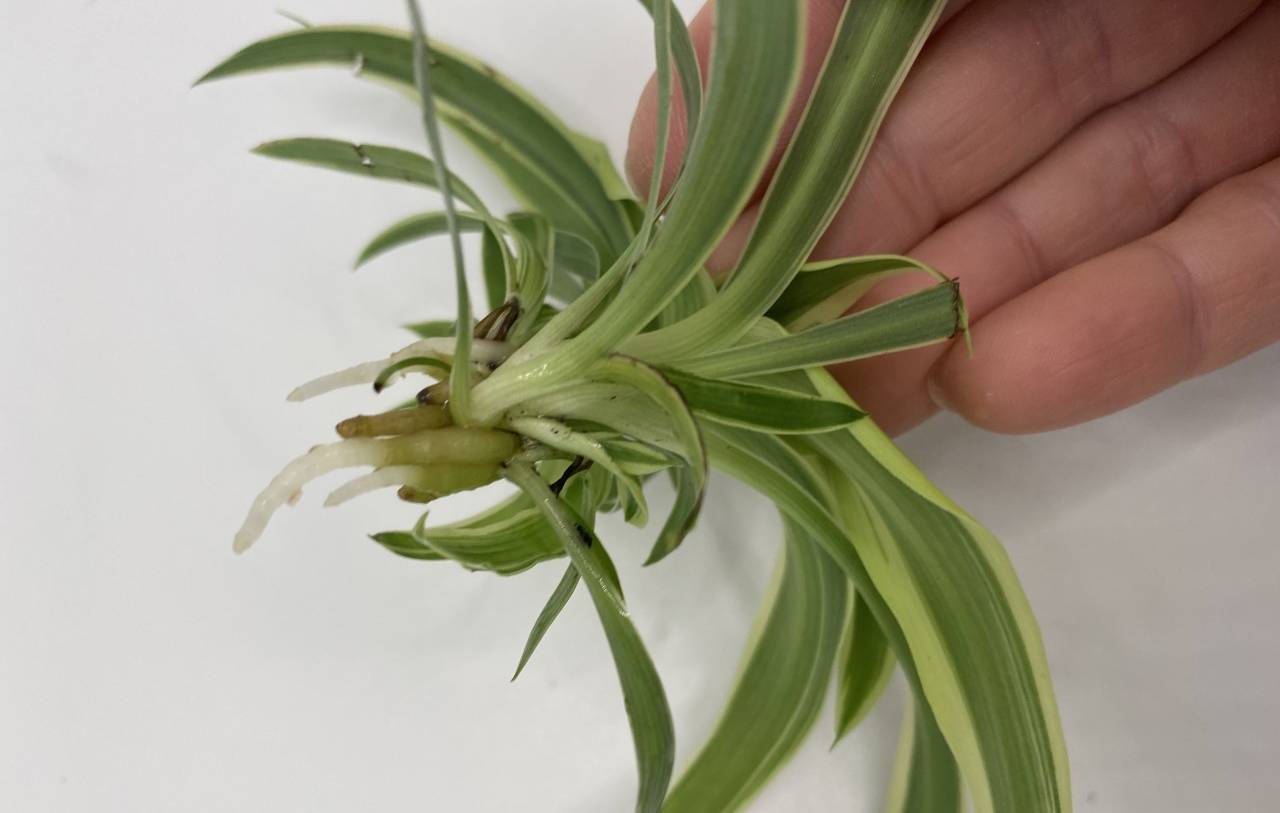
Any plant that produces rhizomes, or underground stems, and any plant that produces a crown and not an elongated above-ground stem can be propagated via division.
How do you propagate using division?
- The best to divide plants is when they are coming out of a period of inactive growth. Usually this is in the late winter or early summer.
- Tear apart the plant. Make sure to keep as much of the root system intact as possible.
- Replant all divisions at the same level they were growing.
You can plant multiple divisions in the same pot in order to achieve the look of a fuller pot sooner.
Air Layering
Air layering is a method best used when a plant is overgrown and the only attractive leaves are those at the end of the stem. This method allows the plant to easily restored to a presentable form. Weeping fig, schefflera, Norfolk Island pine, dumbcane and tree philodendrons are often propa gated using this method.
Usually, rooting techniques require the plant to be taken to the soil, but air layering requires the soil be taken to the plant.
How do you propagate using air layering?
-
If the plant has tree-like bark, the stem should be girdled entirely around the stem and the girdle should be at least one inch wide. If the plant is a dracaena or tree philodendron, cut a diagonal slice halfway through the stem of the plant. This slice should be held open with a small stick.
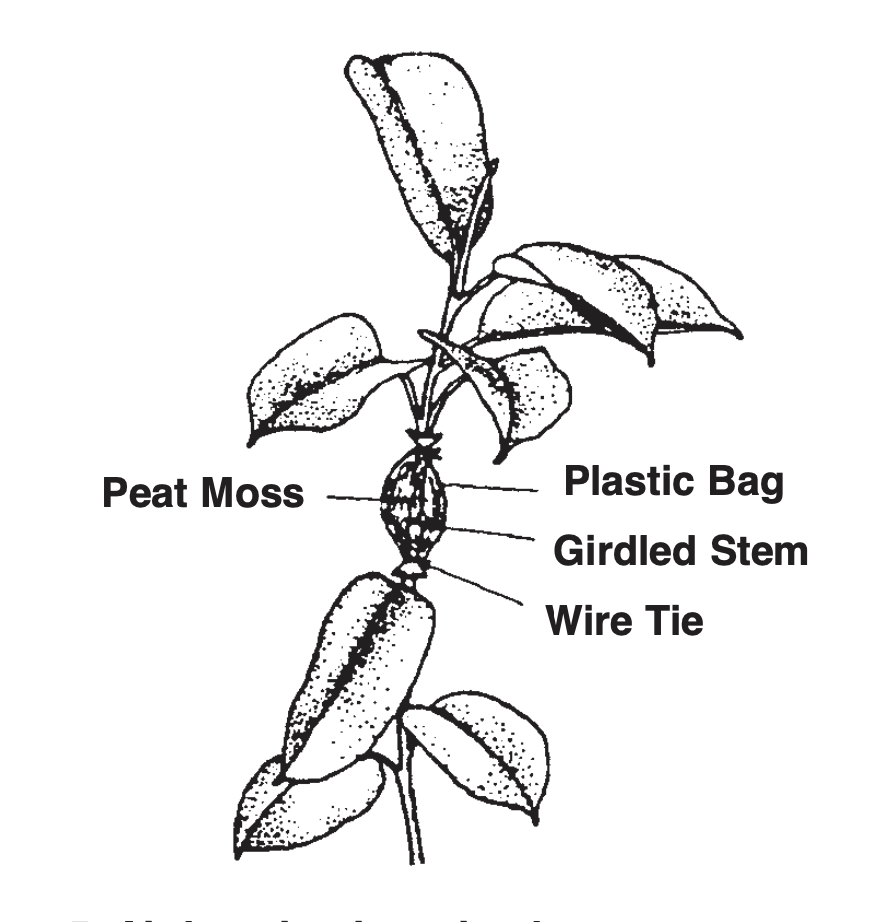 Air layering is a simple way to propagate plants that are greatly overgrown.
Air layering is a simple way to propagate plants that are greatly overgrown. - Dusting rooting hormone onto the wounded area speeds rooting.
- Place a small ball of moist sphagnum peat moss, 4 - 6 inches in diameter, around the wounded area.
- Wrap the ball of peat moss with plastic kitchen wrap or aluminum foil.
- Secure the material by wrapping it with wire ties.
- Inspect the ball every few weeks and water as needed.
- In two - four months, roots should appear. Remove the new plant just below the root ball.
- Repot as with any rooted cutting.
Do not try to layer too large a piece or there may not be enough root system to provide water for the new plant’s needs.
Chart for propagating specific plants
The table below gives propagation methods which may be successfully used for 60 of the most common house plants. The method which is most commonly used, or the method used commercially, is the method designated as “best.” If the technique works but is not commonly used for some reason, it is indicated with a “yes.” If the method does not work, “no” is used. Some groups such as cacti and succulents are generalizations.
Download our factsheet for an accessible version of this chart!
